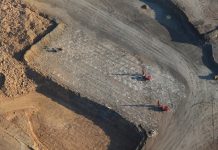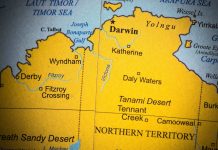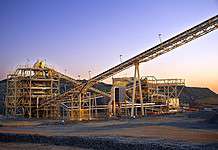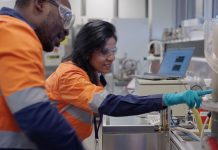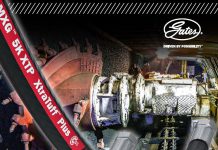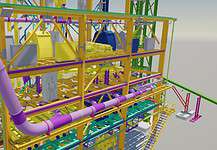RECONDITIONING a heavy diesel engine places a weighty burden of responsibility on the machine shop carrying out the work.
Each component in these engines is expensive and must be stripped, cleaned and machined to exacting tolerances in order for the rebuilt engine to give many thousands more hours of trouble-free operation.
In most instances, the downtime costs resulting from an engine failing in a large haul truck or excavator can approach the cost of the engine itself.
So the stakes are high and only the most experienced and trusted engineering workshops earn the right to bring these iron behemoths back to life year after year.
The Australian Mining Review recently visited R Moore and Sons Diesel Engineers, in Kewdale, WA.
This proud family-owned company has been in operation since 1920 and eagerly anticipates its 100th anniversary next year.
That is a remarkable achievement for any company, enduring the great depression, a world war, the oil crisis and a host of other moments in history that sent lesser businesses to the wall.
Through it all, that sense of family remains and is apparent from the moment you walk through the door and are greeted with a warm welcome.
The sentiment is emphasised by the respect and teamwork that is evident between all employees, from the shop floor to the boardroom.
The scale of the operation and the quality and quantity of the precision machinery on hand is remarkable.
It is clear that only the best will do when it comes to producing the highest quality end result for each component from a 6t cylinder block to a 100g valve guide.
While the company does not actually build complete engines, it does strip, test, measure, analyse, report, repair, recondition, manufacture parts for them and dyno test them.
Each section of the workshop handles a different aspect of the process and the entire shop floor is arranged in a logical sequence from initial delivery to final despatch.
The following photos give a glimpse inside this impressive facility and provide an insight into some of the processes and equipment housed within.
This is by no means a comprehensive pictorial of every service and operation provided but it does focus on the main areas of reconditioning a large diesel engine.
As blocks, cranks, cylinder heads and other components come through the door they are stripped and thoroughly cleaned prior to inspection.
At this point a full report is done on each part, which is then sent to the client prior to work commencing.
The decks on this V16 block have been machined down to remove pitting and corrosion after thousands of hours of service.
R Moore & Sons installs its own liner seat inserts to seal the tops of the wet liners and support each cylinder head.
After this step the decks are reclaimed using metal arc thermal spray.
These Mazak CNC lathes manufacture liner sleeves and inserts from specially cast (in WA) pipe stock.
After metal spraying to reclaim the height of each deck and CNC milling to recut all the holes to perfect OEM specifications, the block is decked in a computer controlled Rottler mill.
Crankshaft grinding is as much an art as it is a science, and it takes an experienced operator and the highest quality equipment to produce perfectly round journals, with the correct surface RA finish and perfect fillets to resist cracking.
Big end and main bearing journal tolerances are measured in microns by a constant grinding gauge while grinding.
The camshaft is the computer of any engine, timing valve events to deliver torque and horsepower at specific rpm points.
Cam lobes are reground using separate master profiles for the intakes and exhausts.
Connecting rods must be resized to ensure that the big end is perfectly round once the cap is torqued to the required setting.
The big end often becomes oval after constant use and that is not a good thing for oil pressure or prolonged bearing life.
The little end bushes are also pressed out, replaced and then machined to OEM tolerances.
Rocker arm bushes are also replaced and machined to spec.
These CAT cylinder heads have been cleaned, machined, fitted with new guides and have fresh valve seats cut.
They await new springs, retainers, valves and collets before they find their way back onto the engine.
The cylinder head sits on a special assembly bench.
Here two brand new valve guides have been fitted and a third is being seated.
The guides are quenched in liquid nitrogen to shrink them prior to fitting (hence their icy exteriors) as they warm the form an interference fit with the cylinder head, locking them in place.
R Moore & Sons builds its own assembly jig to speed up the head building process and to ensure exact tolerances each time.
Here a custom-made press is used to push the guide into the head.
The steel collar ensures that each guide is installed to exactly the right depth.
A special fixture mounted to the press secures the retainer and allows the valve spring to be compressed while the collets are installed.
A look at the face of the new head showing a freshly milled surface and four brand new valves – ready for service.
The in-house dynamometer is rated to 1570kW (2100hp) and allows engines to be fully tuned and tested under load or varying duty cycles before they are shipped thousands of kilometres to site.
Dyno testing is the most reliable way to run-in a new engine, check for problems and ensure it is completely fit for duty prior to installation.
This dramatically reduces the risk of unexpected downtime due to the fitment of an untested engine.
Engine oil samples can also be taken after initial run time and returned within 24-hours to provide critical information on the type and quantity of any metals or other contaminants present in the oil.
Once again, it is cheaper and faster to check the health of a new engine before it heads off to site.
A view of the engine on dyno from inside the control room.
An enormous number of critical temperatures, pressures and flow rates can be monitored and logged in real time as the engine is put through loaded test cycles.
This engine has just returned from the engine builder, after reconditioning, and awaits dyno testing before returning to work.
Part of the diesel rebuilding process involves the reconditioning, repair and balancing of turbochargers.
These turbos are subjected to immense heat and their internals rotate at many thousands of rpm.
Dust ingress and oil sludge build-up over time lead to wear, a loss of efficiency and even complete failure.
Here a rebuilt turbo core is setup in the Schenck balancer. After balancing, this unit will be able to rotate to almost 100,000rpm without a hint of vibration.
Garret from R Moore & Sons mounts the exhaust housing to this newly rebuilt core.
The intake housing is already in place.
This completed turbo is fully rebuilt and balanced. It is now ready for service once again.
Big diesels require large volumes of fuel under incredible pressure.
This manual test bench uses a piston to force diesel through the mechanical injector to test its flow and spray pattern before and after rebuilding.
Without a correctly operating fuel injector pump the engine cannot run at optimum efficiency.
This Bosch test unit allows the entire injection system to be tested and the volume of fuel flow through each individual injector to be measured.
Source:
R. Moore & Sons
(08) 6254 4300
www.moorediesel.com

